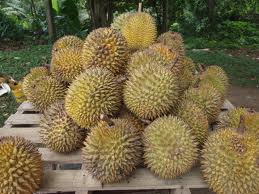The tropical fruit, durian, is specifically native to the countries of Indonesia, Malaysia, and Brunei. It is not sure whether this fruit is native to Davao City, Philippines on the island of Mindanao, where it is abundant.
Davao, the Durian Republic of the Philippines

Southern Mindanao specifically Davao City is known for an odorous but tasty fruit, the durian. It has become an expensive fruit that is sold by the kilo. Better qualities like “Mon thong” and “Channe” varieties are even sold at higher price. Good varieties of durian are sold from 60 to 120 pesos per kilo.
The smell of the fruit is at first disgusting, which makes you reluctant to taste it. However, its excellent taste makes it the most satisfying fruit in the world in spite of its strong odor.
13 Facts About Durian Fruit
How can an odorous fruit like Davao durian be a flavorful favorite in the Philippines? Here are some fast facts you must know about this unusual fruit.
- Durian is a large fruit with a strong odor and an impressive husk consisting of multiple thorns.
- The fruit is native to Southeast Asia but is also known to the Western countries for about 600 years.
- The oblong to round shaped fruit, which belongs to the family Malvaceae and genus Durio, can grow to as large as 12 inches or 30 centimeters in length and 6 inches or 15 centimeters in diameter.
- The weight of a durian fruit can vary from one to three kilograms and its color vary from husk green to brownish as well as flesh pale yellow to red.
- A durian tree is large, about 80 to 164 ft in height depending on the species.

Durian Davao - It bears fruits one or two times in a year. The tree branches can support the fruits at a hanging state regardless of the fruit size. The durian fruit matures about three months after pollination.
- The durian fruit is similar to the outer appearance of the jackfruit which is unrelated to durian.
- The inside of the durian fruit with its unusual flavor and odor consists of a mass of firm edible pulp with a cream color and which contains about three seeds.
- The flavor of the pulp tastes like a rich custard mixed with almonds. The pulp has a rich glutinous smoothness which is neither juicy, sweet or acidic such that the taste of the pulp makes you want to eat more and more.
- Eating excessive amounts of the cream pulp does not cause nausea or any other bad effect.
- The durian fruit is an essential flavoring medium in Malay delicacies such as the Malay candy, rose biscuit, ice kacang, dodol and lempuk and can be mixed in modern cuisines such as ice cream, cappuccino, mooncakes, and milkshakes.
- In Thailand, durian is eaten fresh combined with sweet sticky rice.
- Durian seeds which are as big as chestnuts can be eaten after being roasted, boiled or fried in coconut oil. The seeds may also be sliced, cooked and mixed with sugar as a confection.
You’ve got to taste it to believe it!
If you can’t take the smell of durian, there are still native products where durian is their base ingredient. Your travel to the Philippines won’t be complete without something to bring home (pasalubong) to your families and friends. You can bring home tasty candies, tarts, macaroons, polvoron, barquillos, and other durian treats.